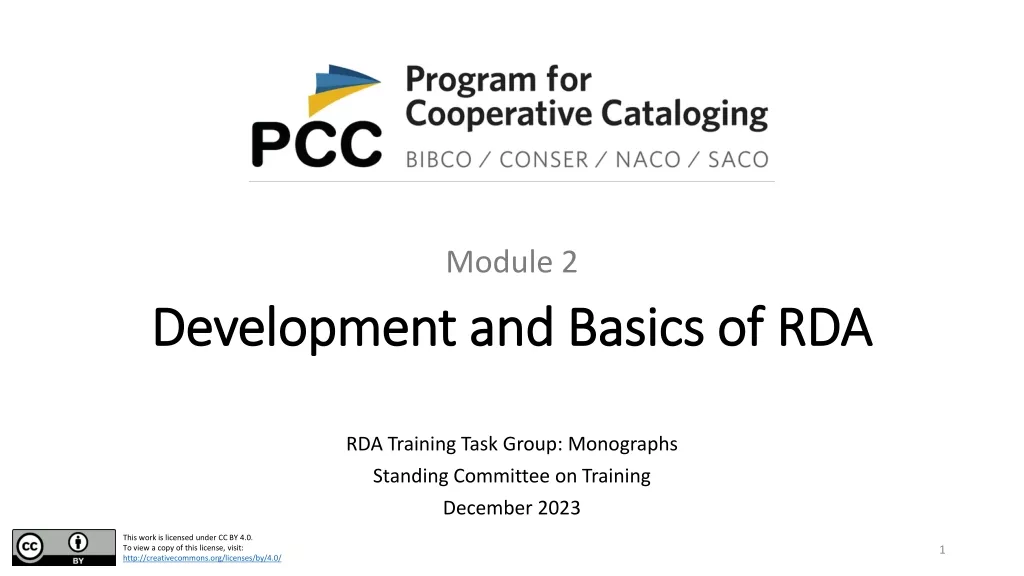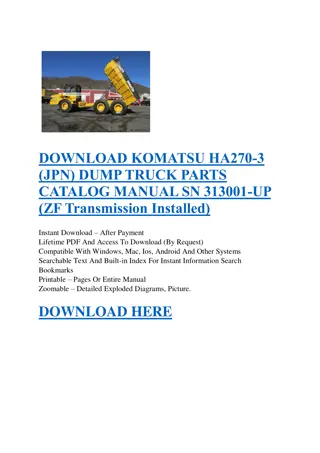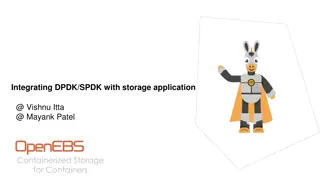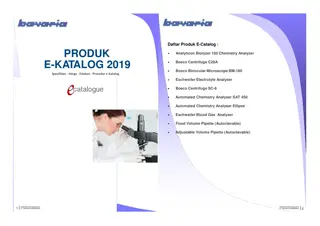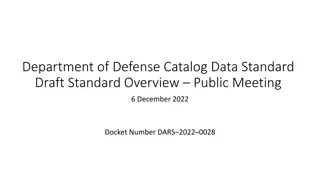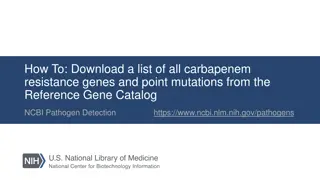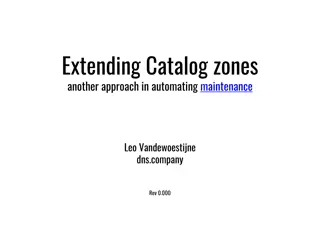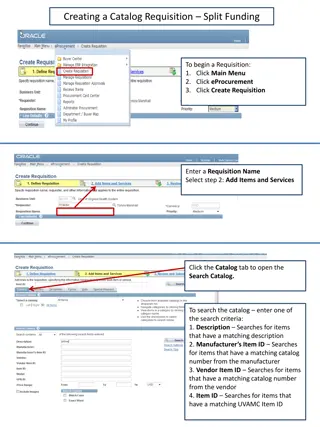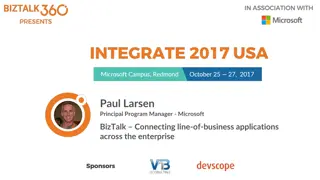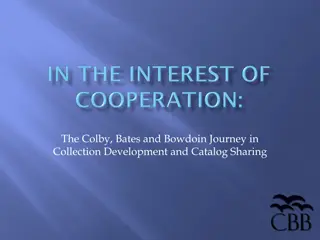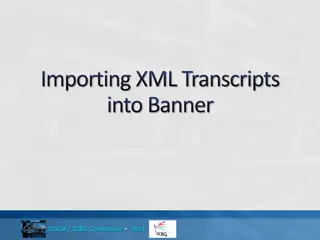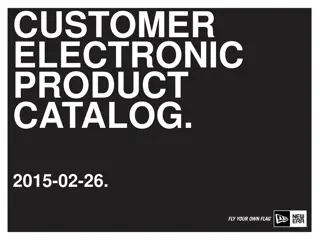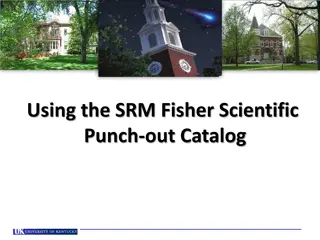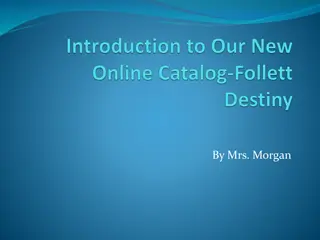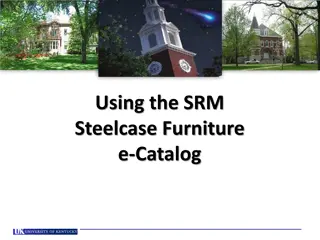Understanding Business Data Catalog for Integrating LOB Data and Applications
Explore the Business Data Catalog (BDC) and learn how to use it within pages, lists, search, and profiles. Discover its functionalities, design motivations, and components such as web parts, user profiles, and custom apps. Get insights into customer feedback, design considerations, and more.
Download Presentation

Please find below an Image/Link to download the presentation.
The content on the website is provided AS IS for your information and personal use only. It may not be sold, licensed, or shared on other websites without obtaining consent from the author. Download presentation by click this link. If you encounter any issues during the download, it is possible that the publisher has removed the file from their server.
E N D
Presentation Transcript
ARC03 Business Data Catalog: Integrating LOB Data and Applications Mike Fitzmaurice Senior Technical Product Manager Microsoft Corporation mikefitz@microsoft.com
Session Objectives Learn what the Business Data Catalog (BDC) is See how to use it within pages, lists, search, and profiles See how to register new applications with the BDC Understand issues with design, security Understand what it doesn t do and how you can address that with additional technology Get an introduction to emerging tools
What is the Business Data Catalog?
Customer Feedback Less custom integration code Deep integration of data into the places users work New application types that blend data, collaboration Need for of structured data search Bridge portal and business application UI Centrally manage security, auditing, connections
Design Motivations Reduce the need for custom front-end code Reuse SOA investments already in place Create manageable method for reusing data Centralized deployment Centralized data security Low latency Designed for portal & collaboration scenarios Data query, indexing, personalization The BDC is not about: transactions, workflow, data transformation, adapters, precomposition
Overview of Components Web Parts User Profiles Custom Apps Lists Search Search Index Profile Store List store Business Data Catalog Metadata WS Proxy ADO.NET BizTalk Server, SAP, Siebel, Legacy, SQL Server, Oracle, OLEDB, ODBC Web Service Database
Business Data Web Parts Routine business apps with no code Scenario 360-degree view of customer Office 2003: Clipping, custom Web Parts, DataViews Office 2007: Reusable business data Web Parts Show new data with no new code or binaries Master-detail applications with no code Integrated with dashboards and filters Customizable in SharePoint Designer
Business Data Search Scenario: find an account manager in Siebel Office 2003: Vertical applications lack full-text search Most users can t locate or access vertical applications Hard to have an index gatherer see business data Office 2007: search any database/Web service Reduced need to write IFilters or protocol handlers No need to create HTML representations of data Integrated with scopes and Search Center Last-minute bonus: custom query-time trimming
Searching Structured Business Data Mike Fitzmaurice Senior Product Manager - Portals Microsoft Office Business Platform
Business Data In Lists Collaborate around business data Scenarios Tag a proposal with a customer Track and annotate key support cases Pick from the canonical list of cost centers Office 2003: Text or lookup fields Irregular data, duplicated lists of values Office 2007: Business data column One column type that stores any entity Integrates with list features: workflow, versioning, etc. One-click refresh
Actions And Write-back Link, don t replicate Scenario Edit customer in SAP Launch InfoPath form for writeback Office 2003: Great actions for people Actions on other data means custom code Office 2007: Actions on any entity Action is just a URL associated with an entity Actions appear everywhere an entity appears Users can take action in context
User Profile Import Business-specific targeting & personalization Scenarios Show news about your customers Automatically filter dashboard by sales rep s region Office 2003: Code required to augment user profile Personalized Web Parts require custom code Office 2007: import business data into user profile Map user profile property to field of entity Filter Web Parts with user profile filters
Development Lifecycle Write Metadata, not Code 1. 2. Analyst defines business requirements IT Pro / developer writes and tests application definition (metadata) IT Pro uploads application definition Analyst builds solution using business data features 3. 4.
Application Definitions Metadata Model Overview System A data source Entity A real-world thing in a System Method An operation on an Entity MethodInstance A way to use a Method E.g. Finder, SpecificFinder, IDEnumerator Association A relationship between Entities Metadata has two purposes Describe a system s API Give meaning to the API; make it easily usable
Application Definitions Properties Every MetadataObject has a Properties collection Business Data Features make use of certain annotations You can extend the metadata for your own applications <Entity Name= Customer > <Properties> <Property Name= Title >CustomerName</Property> </Properties> ... </Entity>
Application Definitions Finder Methods One method of an entity is designated the Finder, another the SpecificFinder Finder returns a collection of instances given a set of filters SpecificFinder returns a single instance given a key <Entity Name= Customer > <Methods> <Method Name= GetCustomer > <MethodInstance Type= Finder ... /> ... </Method> </Methods> </Entity>
Application Definitions Filters Control the data that Finder methods return Annotations on a Method s input parameters Declare which inputs users can override Various types: wildcard, exact match, System filters allow BDC to securely set values, e.g., user token <Method Name= GetCustomer > <FilterDescriptors> <FilterDescriptor Name= Region Type= ExactMatch /> </FilterDescriptors> <Parameters> <Parameter Name= Region Direction= In > <TypeDescriptor ... AssociatedFilter= Region /> ... </Method>
Application Definitions Associations Model relationships between entities Has one or more source entities and one destination entity Is a method instance Takes source instance(s) and returns a destination instance <Association Name= CustomerToOrder AssociationMethodName= GetOrdersByCustomer > <SourceEntity Name= Customer"/> <DestinationEntity Name= Order"/> </Association>
Application Definitions IDEnumerators And Search Full-text search any application BDC crawl protocol has two phases ID Enumeration: Fetch all entity instance IDs Detail fetch: Fetch details for each instance IDEnumerator returns the IDs SpecificFinder returns the details <Method Name= GetCustomerIDs > <Parameters> ... </Parameters> <MethodInstance Type= IDEnumerator ... /> </Method>
Application Definitions Actions Link, don t replicate Scenarios so far are read-only For writes, link to InfoPath forms, web forms, or app UI Actions are links that travel everywhere with an entity Users can take action in context <Entity> <Actions> <Action Name= Edit Url= http://customerweb/edit.aspx /> </Actions> </Entity>
Application Definitions AuthN, AuthZ, And Auditing Centralized security and auditing Two authentication patterns Trusted subsystem Impersonation / delegation Two authorization patterns Mid-tier authorization Backend authorization One place to audit Log who accesses which data when
Tools for Building Definitions Metadata Manager for MOSS 2007 BDC http://www.bdcmetaman.com/ Free version for SQL Server data sources Licensed version adds Web service, Oracle, ODBC Action builder Visual designer Multiple entity support Configuration of LOBSystems, LOBSystemInstances, Entities, Methods, etc. Various efforts on CodePlex, GotDotNet BDC Metadata Editor Not-yet-released, semi-supported tool written by development team Runs on server, edits BDC metadata store directly
Application Generation Tools
Business Data Catalog API Two halves: Runtime and administration Runtime API Browse metadata, execute methods, retrieve instances, traverse relationships For custom application builders Administration API Create, read, update, and delete metadata and manage permissions For administrators For ISVs building metadata management tools OOB features use these public APIs
Integration Prerequisites Communication SOAP ADO.NET Authentication MOSS SSO Kerberos Composition LOB Vendor middleware BizTalk Server 3rd Party middleware or custom components
What About Write-back? Use custom actions to take users to: Server-side InfoPath forms Custom ASP.NET pages The LOB vendor s own Web interface
What About LOBi? LOBi was introduced last June at Tech-Ed Boston as a technology Appeared to be a technology at the time There was a reorganization LOBi is now one of the teams under MOSS 14 The old BDC team is part of the LOBi team Envisioned key features (all subject to change) Client-side functionality (in addition to server-side) Write-back Composition
Summary / Call to Action The BDC s job is to reduce, perhaps eliminate, custom code on the front-end You still need to: Expose LOB data You ve been doing this anyway, we hope, for SOAs Make sure the exposed data makes sense Provide a usable means of identity sharing MOSS provides SSO, Windows provides Kerberos This has a bright future, and the next release will build forward from this investment
Additional Information SharePoint Team Blog http://blogs.msdn.com/sharepoint SharePoint Server 2007 Developer Portal http://msdn.microsoft.com/office/sharepoint Product information http://www.microsoft.com/sharepoint



